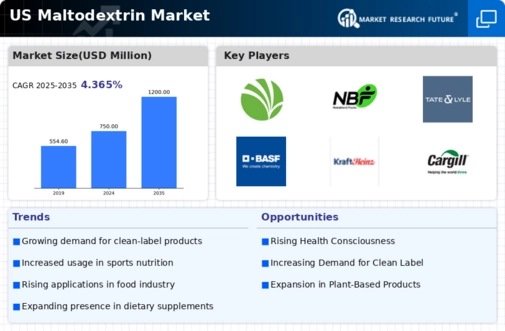Growth in Convenience Foods
The increasing popularity of convenience foods is a significant driver for the maltodextrin market. As lifestyles become busier, consumers are gravitating towards ready-to-eat meals and snacks that offer convenience without compromising on quality. Maltodextrin serves as an effective bulking agent and stabilizer in these products, ensuring they maintain their texture and flavor. The convenience food segment is estimated to represent around 30% of the maltodextrin market in the US. This trend suggests a sustained demand for maltodextrin as manufacturers strive to meet consumer expectations for quick and easy meal solutions.
Expansion of Sports Nutrition Products
The expansion of the sports nutrition market is significantly influencing the maltodextrin market. As more consumers engage in fitness and health-oriented lifestyles, the demand for energy-boosting supplements has escalated. Maltodextrin is favored in this sector due to its rapid digestibility and ability to provide quick energy. Reports suggest that the sports nutrition segment is projected to grow at a CAGR of 8% over the next five years, further solidifying maltodextrin's role as a key ingredient in energy drinks and protein powders. This trend not only enhances the visibility of maltodextrin but also positions it as a staple in the formulation of performance-enhancing products.
Increased Focus on Dietary Supplements
The growing focus on dietary supplements is emerging as a key driver for the maltodextrin market. With a rising awareness of health and nutrition, consumers are increasingly seeking supplements that support their dietary needs. Maltodextrin is often used as a carrier for vitamins and minerals, enhancing the bioavailability of these nutrients. The dietary supplement sector is projected to grow at a CAGR of 7% in the coming years, indicating a robust market opportunity for maltodextrin. This trend underscores the ingredient's versatility and its integral role in the formulation of health-oriented products.
Rising Demand in Food and Beverage Sector
The maltodextrin market is experiencing a notable surge in demand, particularly within the food and beverage sector. This growth is largely attributed to the increasing consumer preference for processed foods that require stabilizers and thickening agents. Maltodextrin, being a versatile ingredient, is widely utilized in various applications such as snacks, sauces, and beverages. According to industry reports, the food and beverage segment accounts for approximately 60% of the total maltodextrin consumption in the US. This trend indicates a robust market potential, as manufacturers seek to enhance product texture and shelf life, thereby driving the maltodextrin market forward.
Technological Advancements in Food Processing
Technological advancements in food processing are playing a crucial role in shaping the maltodextrin market. Innovations in production techniques have led to improved quality and functionality of maltodextrin, making it more appealing to food manufacturers. Enhanced processing methods allow for better control over the molecular weight and viscosity of maltodextrin, which can significantly impact its application in various food products. As a result, the market is witnessing an influx of new product formulations that leverage these advancements, thereby expanding the overall maltodextrin market. This trend indicates a dynamic landscape where technology and ingredient functionality converge.

















Leave a Comment